

How To Clean & Rejuvenate Old Air Stones. Save some pennies by learning how to clean and rejuvenate old clogged air stones to reuse them with these simple instructions from your Guides.
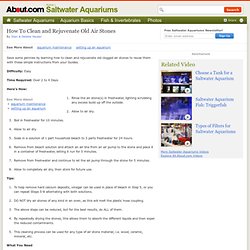
Difficulty: Easy Time Required: Over 2 to 4 Days Here's How: Rinse the air stone(s) in freshwater, lighting scrubbing any excess build up off the outside.Allow to air dry.Boil in freshwater for 10 minutes.Allow to air dry.Soak in a solution of 1 part household bleach to 3 parts freshwater for 24 hours.Remove from bleach solution and attach an air line from an air pump to the stone and place it in a container of freshwater, letting it run for 5 minutes.Remove from freshwater and continue to let the air pump through the stone for 5 minutes.Allow to completely air dry, then store for future use. Tips: What You Need BleachVinegarFreshwaterWater ContainerUsed Air Stone(s) Guide of Tropical Aquarium Fish. Problem solver: New Tank Syndrome. Home » Features » Tropical fish Copyright © Neil Hepworth Bad water is the biggest killer of fish in the aquarium and New Tank Syndrome (NTS) is one of the most common causes.
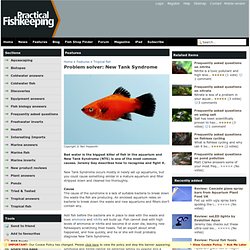
Jeremy Gay describes how to recognise and fight it. New Tank Syndrome occurs mostly in newly set up aquariums, but you could cause something similar in a mature aquarium and filter stripped down and cleaned too thoroughly. CauseThe cause of the syndrome is a lack of suitable bacteria to break down the waste the fish are producing. Add fish before the bacteria are in place to deal with the waste and toxic ammonia and nitrite will build up. SymptomsAmmonia and nitrite cannot be detected simply by looking into a tank. Typical symptoms can be fish refusing to feed, looking lethargic, hanging at the surface, rolling over in midwater or sudden unexplained deaths throughout a cross section of the species in your tank.
New Tank Syndrome. New Tank Syndrome In established aquariums, just as in nature, toxic ammonia from fish waste is broken down by bacteria into nitrite, which is itself broken down by a different group of bacteria into nitrate.

In a newly set up aquarium, those bacteria are not present in any quantity, and it takes time - about a 4 to 6 weeks under normal circumstances - for those bacteria to multiply to the point of being able to keep up with the waste output of the fish. “New Tank Syndrome” and “The Break-In Cycle” describe the period in which ammonia and then nitrite levels rise to dangerous quantities before being converted into relatively harmless nitrate.
A tank need not be “new” to go through this break-in process. That thirty year old metal frame tank you drag out of the attic will cycle just like the sparkling new acrylic one you just bought this afternoon. A Typical Break-In Cycle. Planarian. Polycelis felina, a freshwater planarian Unidentified planarian.
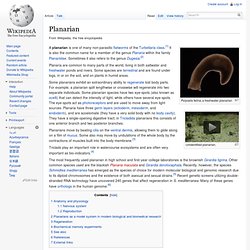
Planaria are common to many parts of the world, living in both saltwater and freshwater ponds and rivers. Some species are terrestrial and are found under logs, in or on the soil, and on plants in humid areas. Planarians move by beating cilia on the ventral dermis, allowing them to glide along on a film of mucus. Some also may move by undulations of the whole body by the contractions of muscles built into the body membrane.[3] Triclads play an important role in watercourse ecosystems and are often very important as bio-indicators.[4] The most frequently used planarian in high school and first-year college laboratories is the brownish Girardia tigrina. Anatomy and physiology[edit] The planarian has very simple organ systems. Planaria receive oxygen and release carbon dioxide by diffusion. Nervous system[edit] Planaria nervous system At the head of the planarian there is a ganglion under the eyespots.
Reproduction[edit] What are These Tiny White Worms? Question: What are These Tiny White Worms?
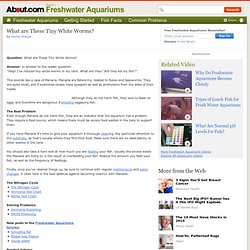
Answer: In answer to the reader question:"Help! I've noticed tiny white worms in my tank. What are they? Will they kill my fish? " This sounds like a case of Planaria. Although they do not harm fish, they love to feast on eggs, and therefore are dangerous if breeding egglaying fish. The Real Problem Even though Planaria do not harm fish, they are an indicator that the aquarium has a problem. If you have Planaria it's time to give your aquarium a thorough cleaning. Tropical Fish Problem Solver Chart.
Tropical Fish Problem Solver Chart Used with permission from our good friends at Jungle® Labs Scroll down to see the Problem Solving Chart.
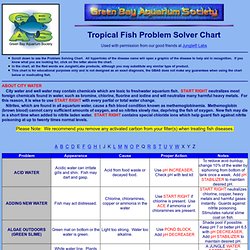
All hyperlinks of the disease name will open a graphic of the disease to help aid in recognition. If you know what you are looking for, click on the letter above the chart. In the chart, all the Red words are Jungle®Labs products, although you may substitute any similar type of product. City water and well water may contain chemicals which are toxic to freshwater aquarium fish. Nitrites, which are found in all aquarium water, cause a fish blood condition known as methemoglobinemia. Please Note: We recommend you remove any activated carbon from your filter(s) when treating fish diseases.
*Monogenetic trematodes are Flatworms and Flukes that require no intermediate host to multiply and spread to other fish. Events Members Join BAP Home Conversion Tables Links Contact Us Classified Ads Photo Gallery Articles Glossary Contact the webmaster.